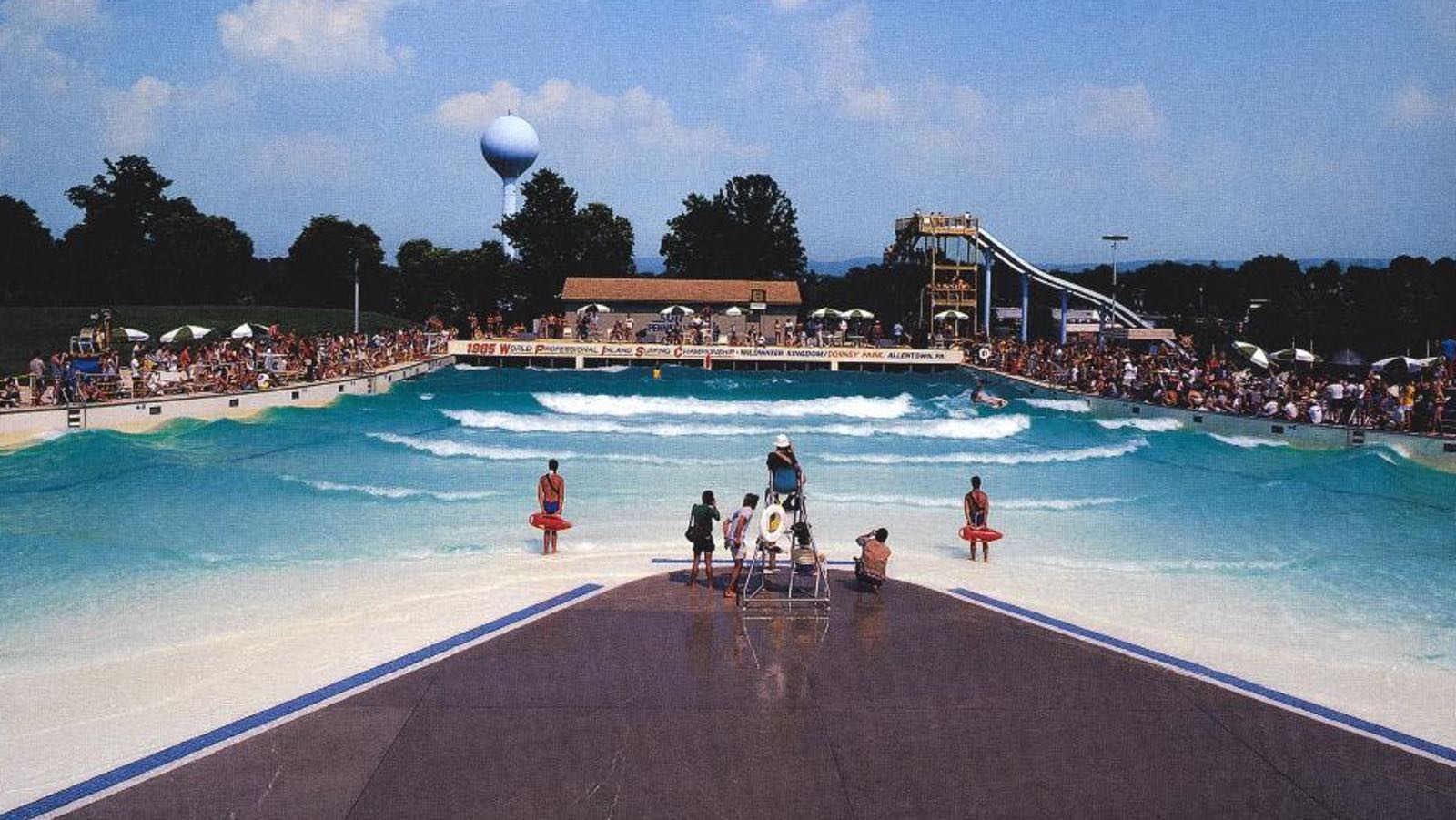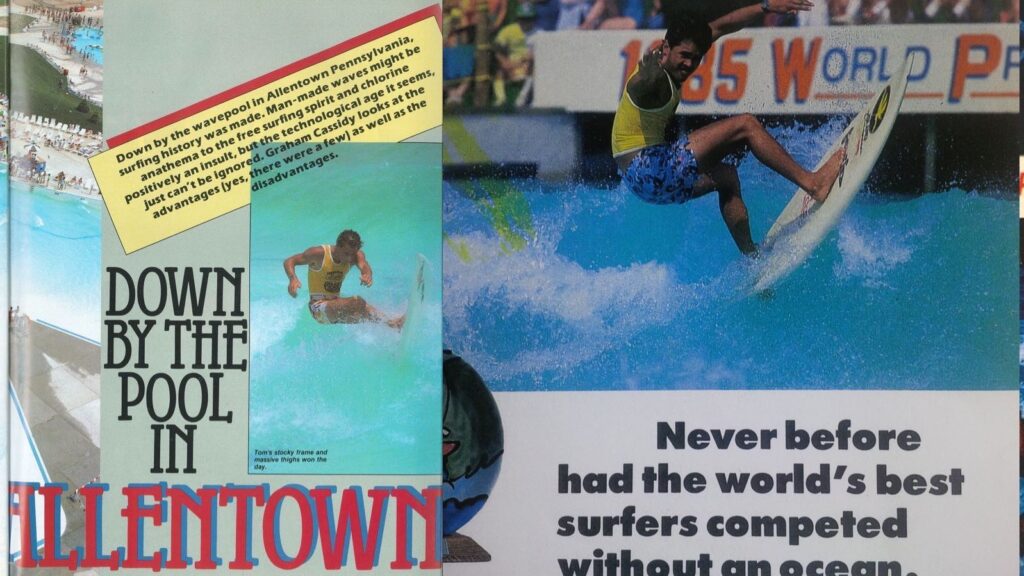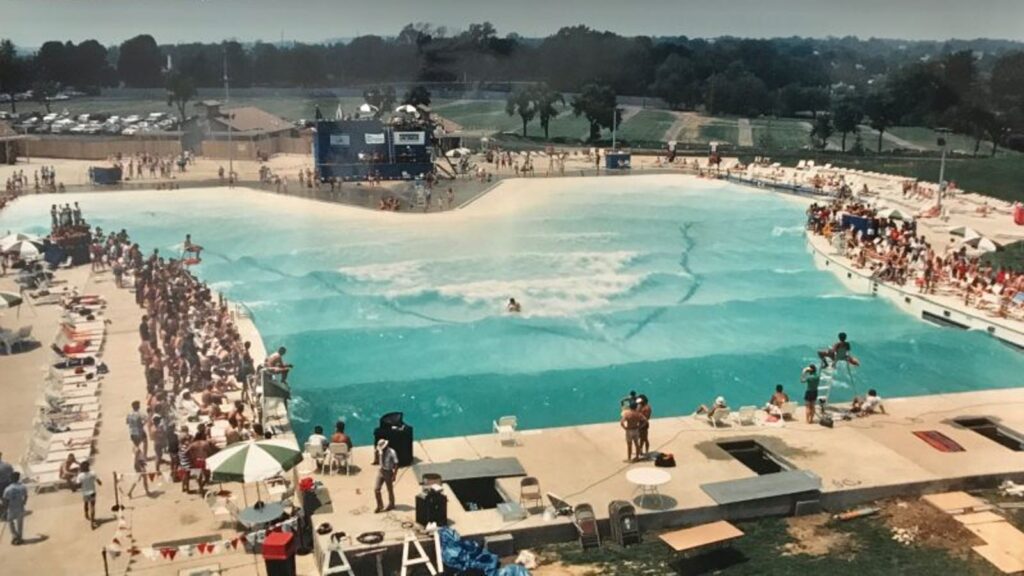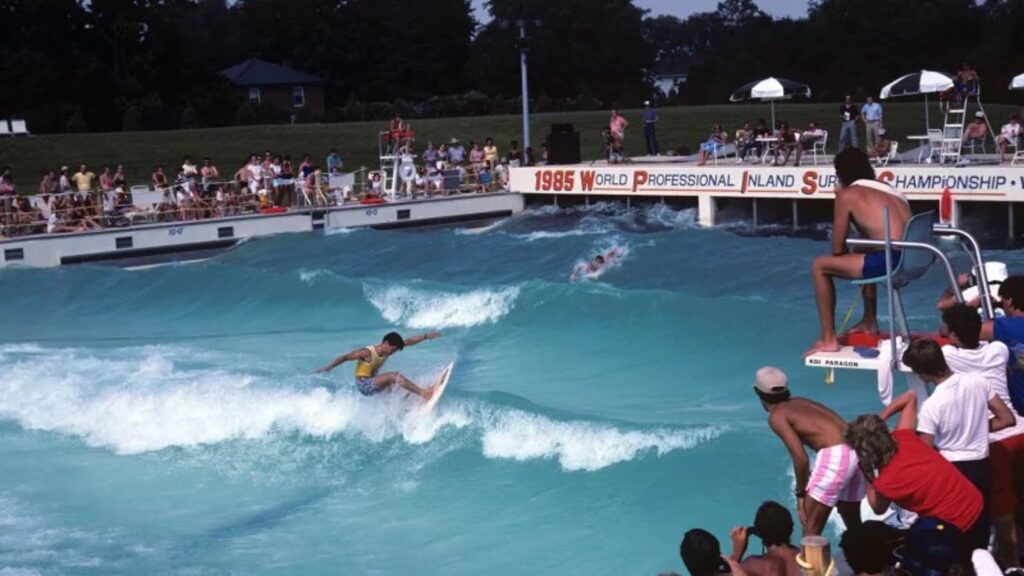Mullets & acid wash in Allentown: Surfing’s first pro pool comp

Main Image by Matt George
In 1985 the planned union of wave pools and high-performance surfing caused barely a ripple in the collective surf world. No one had any idea what to expect – least of all professional surfers.
It takes people keen to try something new to get others to think outside the box. If people are unwilling, drag them into the future. Or lure them with US$25,000 of prize money.
Jim Karabasz, pool owner Bobby Plarr, along with Ian Cairns and Peter Townsend from the Association of Professional Surfing (ASP – the surfing world tours’ governing body at the time), agreed that what surfing needed was the world’s best surfers in the world’s newest wave pool.
Say hello to the Dorney Park & Wild Water Kingdom in Allentown, Pennsylvania. Completed in April 1985, it was finished just in time to host the ASP event, held June 19 to 23.
That’s a seemingly tight window for any venue-to-event, particularly an untested one. So how did it come about?

The concept of a pro event here was brewing well before spades were in the ground. Bobby was keen to attract surfers and garner publicity for his new pool. And luckily, experienced amateur contest surfer and owner of a fleet of inland pool concession stands (under the name ‘Surf Vibrations,’ renting out body boards and the like), Jim Karabasz, knew who to talk to.
“I contacted the ASP, and I spoke extensively with tour directors Ian [Cairns] and Peter [Townsend] (1976 World Surf Champ), and Ian saw the potential as clearly as Bobby and I did,” said Jim.
Busting Down The Door alum Ian Cairns believed the venue would forever change professional surfing.
“I thought it sounded fantastic for the future of the sport,” Cairns told the Morning Call (Allentown’s local paper) on the eve of the competition. “We’re taking the sport to the people.”
Cairns also envisioned an “inland tour,” which Jim believed would be ideal for spectators and better for TV and business.
“At televised beach events, TV crews set up and sometimes have to wait for days for the best waves, a waste of time and money,” said Jim.
He also pointed out in the same article that a wave pool would give the surfers a studio, and the audience would have a 360-degree view of the event and better seating and nearby concessions. A view as valid now (cue the Corona cabanas at Kelly’s pool and restaurants at nearly every other commercially operating wave pool) as it was then.

World Champ turned marketing savant Peter Townend saw the potential as well.
“The year before I had surfed the wave pool in Geuaga Lake, Cleveland in the middle of America, so we knew wave pools had potential”, said PT. He also credits Kanga’s foresight to sanction the Dorney Park, Allentown event, and Tom Carroll winning it as endorsing the concept’s competitive validity.
“Funny here we are near forty years later and the WSL Surf Ranch is as stop on the Championship Tour, Kanga’s vision has become a reality permanently to this point”, said PT.
Some of the world’s best surfers in 1985 had a different view. As Tom Carrol recalled in a 2012 Surfer Magazine article,
“We got out of the car—Pottz [Martin Potter], Elko [Gary Elkerton], Mr. X [Glen Winton], and I — and we’re standing there with our boards looking at a swimming pool, going, ‘Is that it?’ I remember thinking at the time; this is the weirdest place on the planet for a surfer to be.”

The event attracted 70 surfers, including 25 of the world’s top 30. It was one of 19 stops on the tour that year and one of only two held on the US mainland.
According to Jim the pool was powered by a Wave-Tek paddle system, producing a wave every four-to-five seconds, giving approximately 720 per hour. “Waves were knee to waist high, and with the pool being heart-shaped, you could choose to go right or left,” said Jim.
Waves were continual when the machine was switched on, so the pool had no “downtime” to settle. And Jim reckons the displaced water returned along the sides of the pool, which in turn created a bigger and steeper section next to the wall on the right-hand side.
The pool was open for practice two days before the event, with 20-minute heats over the five days.
According to Jim, people drove from Virginia, Florida, and all along the Eastern Seaboard to see the event. He notes that spectators stood two deep around the pool for the first few days and were “five or six deep” for the Sunday finals. There were 5,000 spectator tickets sold on the final day.
Media coverage of the event was split between the mainstream, which portrayed it as innovative and exciting, and the surf media, which railed against it, ridiculing the waves’ lack of size and power. Though it must be noted the surfers just brought their small-wave boards, which didn’t work well. Only Tom Curren considered bringing epoxy boards to counter saltwater-to-freshwater buoyancy issues.
Two years after the Allentown event “The North Shore” premiered and embedded the concept of Rick Kane in the psyche of surfers everywhere.
Tom Carrol took home the winnings of $4500 and surfing’s elite hot-footed out of the Wild Water Kingdom. Ultimately, the event never returned to Allentown; it was a victim of its own success.
Because of the event, the wave pool and water park became extremely popular, and taking the pool out of circulation for another seven days would have proven economically disadvantageous. Plus, the timing for the tour was going to be tough for the park to accomplish. The ASP wanted the 1986 event to occur in either April or late September. “Neither of these worked for the park to get much of a ‘Marketing Bounce,’ but I’m sure this could have been figured out,” said Jim.
Today, The Dorney Park & Wild Water Kingdom is open to the public, and the wave pool is still there.
“It doesn’t produce surfing waves for visitors anymore,” said Jim, “but it still can,” he hastened to point out.
Time for a rematch? Get Gabby and John John on the line!
Related Coverage
